A Chapel Hill “Rite of Spring” will be carried out in Charlotte this year. Head Football Coach Larry Fedora will take his Tar Heels to the Queen City for the 70th anniversary Blue-White football game because the renovations being carried out at Kenan Stadium will not be completed in time for the game on Saturday, April 11, 2015. [4/11/15 Update: according to GoHeels.com, the team is calling this a “open spring football scrimmage,” adding “Carolina will not have a traditional Spring Game in Chapel Hill due to ongoing repairs to the Kenan Stadium playing surface.”]
The annual spring game goes all the way back to 1946 when then Head Coach Carl Snavely put his post World War II squad on display in Kenan Stadium. Hugh Morton, as you might have suspected, photographed some of these early contests. Unlike his negatives for UNC basketball’s version of the Blue-White game, which are identified, Morton did not label his football negatives for the spring outing. I turned to newspapers looking for articles and images, then looked through hundreds of unlabeled negatives; Morton collection volunteer Jack Hilliard looked over news reports from the Daily Tar Heel, Greensboro Daily News, Wilmington Morning Star, and Charlotte News. The result? Jack’s piece for today’s post on the beginnings of a Tar Heel tradition . . . and a few more identified negatives than we had beforehand.
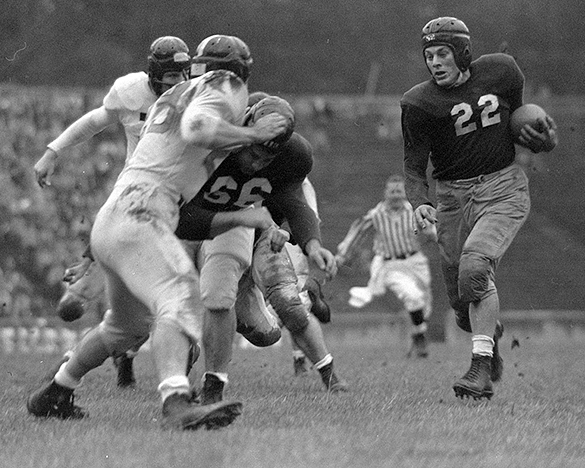
Thirteen days after UNC Head Football Coach Carl Snavely got his Valentine wish that Charlie Justice would “come out for the team,” a practice game was held in Kenan Stadium between the Tar Heels and the Guilford College Quakers coached by Doc Newton. About a thousand students showed up despite the cold, damp, windy weather. The students were surprised when Snavely sent his team onto the field and Justice remained on the sideline. The modified format game gave Guilford the ball first and they did well. When the Tar Heels took over the ball, it was at their own 34-yard-line. On the sideline, Snavely snapped, “Justice, try tailback for a while.” As Justice ran onto the field, the crowd came to its feet. The Quaker defense dug in. Justice was on trial.
As everybody suspected, Justice got the snap. He started out to his right, then peeled off between the tackle and end, and was into the secondary. Two Quaker linebackers missed tackles, and now Justice was in position to size up the safety man. He ran directly at this last line of resistance, applied a head and shoulder fake and breezed past, then angled into the end zone. There was stunned silence in Kenan Stadium as the onlookers tried to figure out what they had just seen. Then a spontaneous cheer went up.
The United Press story in the Greensboro Daily News issue of February 28, 1946 said: “If his initial showing is any indication, Charlie Justice, the University of North Carolina’s new football star, can expect to cause opponents plenty of unrest.”
As the 1946 spring practice came to a close, Coach Snavely along with the University Monogram Club staged something new. They divided the 70-man football squad into two teams for a special game in Kenan Stadium. It was billed as the first annual Blue-White game and was played on May 4, 1946 before 2,000 top-coated fans. Charlie Justice, who had gotten a lot of ink in the papers by now, was assigned to the White team.
The Blue team got the ball first but after about two minutes, they punted. On the first play from scrimmage, with the ball at the White 35, Justice took off around right end. To quote Yogi Berra, “it was déjà vu all over again.” This time the play covered 65 yards. The White team went on to win that first Blue-White game 33 to 0. The ’46 Tar Heels finished the season 8-1-1 and it was “Happy Times are Here Again” in Chapel Hill.
Word of the successful 1946 Blue-White game spread quickly and when the 1947 game rolled around, 7,000 fans turned out on a warm April Saturday. The ’47 game had all appearances of a regular game as two squads of 41 players each met in Kenan on April 26, 1947. Unlike the ’46 game, this game was a tight, hard-fought contest with the White team winning in the end over the Justice-led Blue team 7 to 6. Place-kicker Bob Cox made the difference. It would be Charlie Justice’s only Blue-White loss. Although the 1947 Tar Heels lost 2 games—one to Texas and one to Wake Forest—and they chose not to accept a bowl invitation. Coach Snavely often said he thought his ’47 Carolina team was his best.
By April 29, 1948, Carolina had completed all of its spring practice and work was under way by the Monogram Club for the third annual Blue-White game to be staged in Kenan on May 1st. Once again, Coach Carl Snavely divided his troops into two teams: the White team to be coached by Jim Gill, and the Blue team to be led by Max Reed. This time 10,000 sun-baked fans came out to see what the ’48 Tar Heels had to offer. As it turned out, they had plenty to offer. The White team with Justice and Art Weiner at the controls scored three touchdowns in the first half and added two more in the second, making the final 35 to 7. The third annual Blue-White game introduced a new Carolina tradition. Head Cheerleader Norman Sper presented for the first time on the East Coast the 2,000-student Carolina Card section. They performed eight different stunts, to the delight of the crowd. The 1948 Tar Heels were undefeated: a tie with William & Mary was the only blemish on an otherwise perfect season. The stage was set for the final season of the “Charlie Justice Era,” but it would not be Charlie’s final Blue-White game.
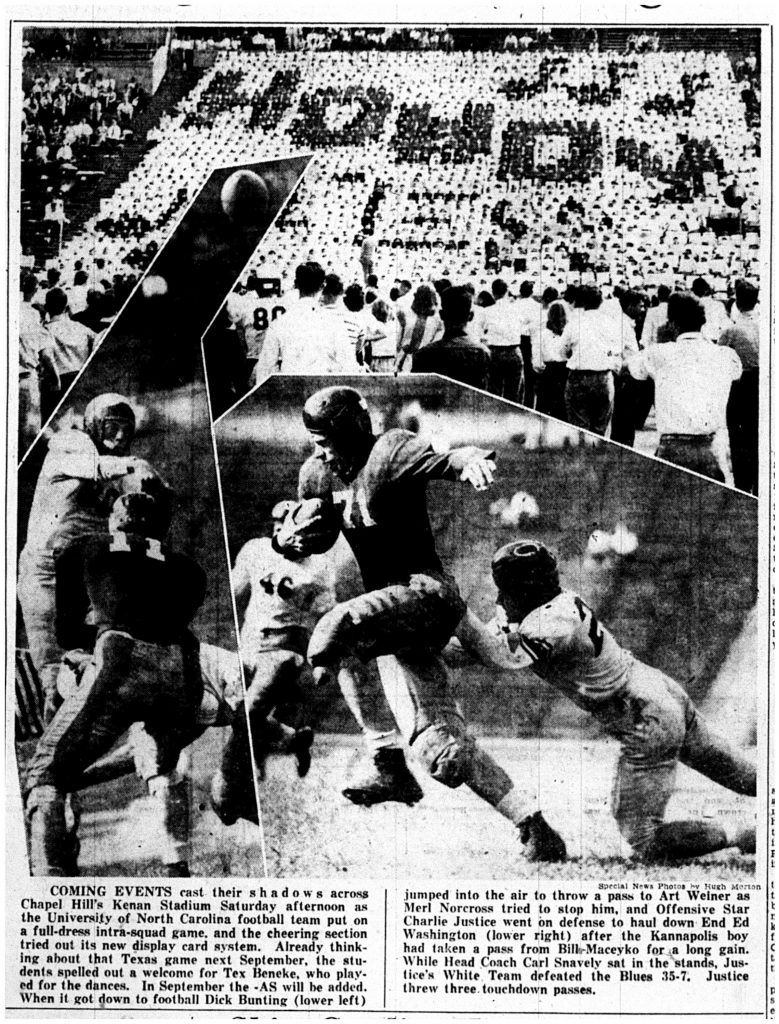
Here’s a PDF of the above news clip: CharlotteNews_19480503_p6B. Only one negative from this trio has been located thus far:

The format for the fourth Blue-White game in 1949 was slightly different from years past. Upperclassmen like Justice and Weiner made up the Blue team, while freshman made up the White team. A Kenan Stadium crowd of 12,000 sat through a first-quarter rain and saw Justice run for one touchdown and pass for two as the “old guys” beat the “rookies,” 21 to 6.

Special guests for this game were 5,000 high school students from across the state.
Photographer Hugh Morton attended several Blue-White games over the years. His classic shot of Justice at the ’49 game (seen at the top of of this article) is a scene many had come to expect in their Sunday papers.
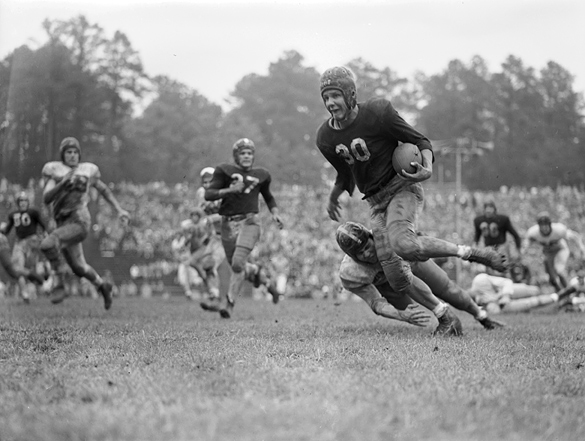
Here’s a PDF of the article and two photographs as they appeared in theMay 2nd edition of The Charlotte News: CharlotteNews_19490502_p4B
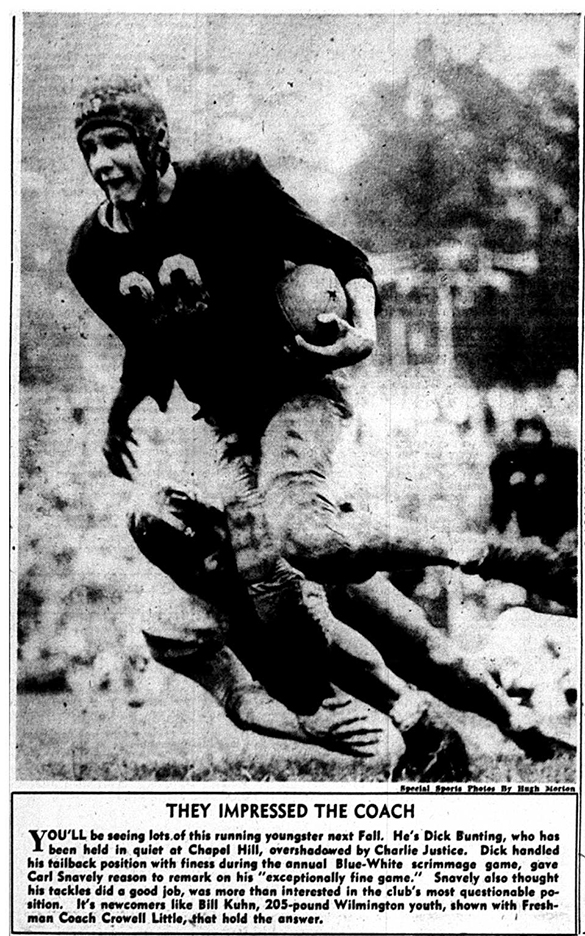
The 1949 Tar Heels lost three games during the season but still won the Southern Conference title and played in the 1950 Cotton Bowl on New Year’s Day.
May 6, 1950, UNC’s Monogram Club staged its fifth Blue-White with yet another format change. This time it was the “Old Grads,” vs. the 1950 varsity. As you might guess, Charlie Justice and Art Weiner were co-captains for the “Grads.” 19,000 fans endured 90 degree temperatures and saw Justice steal the show once again, carrying the ball 12 times.
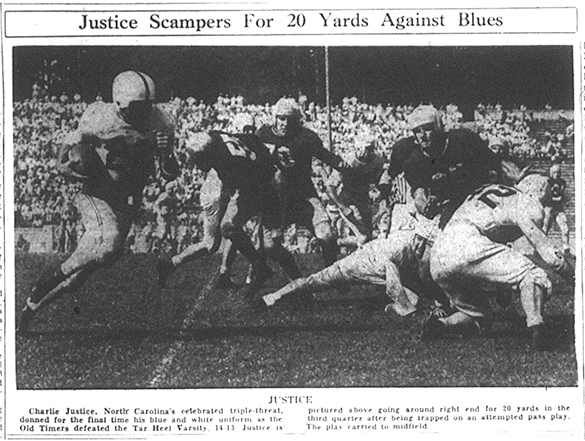
The “Choo Choo” had five punts for an average of 51 yards-per-kick. The star for the varsity was sophomore tailback Ernie Liberati who just happened to be the subject of Hugh Morton’s photo in the Greensboro Daily News issue of May 7, 1950. Morton, in an impromptu interview with Daily News Sports Director Smith Barrier said, “Fish are beginning to bite around Wilmington.” With all the big guns gone, the 1950 Tar Heels struggled, posting a 3-5-2 record for the season.
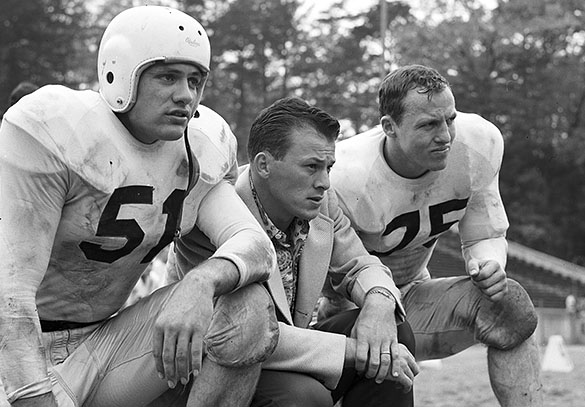
On April 28, 1951, the UNC Monogram Club staged the sixth Blue-White game in perfect football weather before 11,500 fans in Kenan Stadium. The varsity (White) vs. freshmen (Blue) format was in place once again, and as before the varsity proved to be too much for the “rookies.” Coach George Radman’s White team won 32 to 21. Radman’s assistant coach was Charlie Justice, participating in his sixth Blue-White game. Justice was on Snavely’s staff during the 1951 season before returning to his duties with the Washington Redskins for his second Redskins season in 1952. The ’51 Tar Heels finished the season with a 2 and 8 record. Snavely would have only more season with the Tar Heels.
The Blue-White games just kept on coming and in the1962 game, the Monogram Club brought back the 1950 format with the Varsity (Blue) and Alumni (White). At age 37, Charlie Justice participated in his seventh and final Blue-White game. On April 7, 1962, Justice was used as the Alumni punter and got off punts of 35, 40, 39, 37, and 19 yards. The headline in the Greensboro paper on April 8, 1962 read, “Justice Booms Punts Again,” and the headline on page 219 in the 1963 UNC Yearbook, “ Yackety Yack,” read “Choo-Choo Returns for Alumni Game.”
So, when UNC Head Football Coach Larry Fedora’s 2015 Tar Heels take the field at Rocky River High School in Charlotte at 1 pm on April 11 for the 70th anniversary Blue-White spring game, I choose to believe that Justice, Weiner, Snavely and Morton will be together again, watching a Tar Heel Tradition in Blue and White.
Skip to content
Processing the Hugh Morton Photographs and Films

Sounds like Saturday’s “open spring football scrimmage” in Charlotte went well.
http://www.charlotteobserver.com/sports/college/football/article18294653.html
It’s always interesting to find an additional source for information that we have used in a “View to Hugh” post.
In this Blue-White football post from last month, we talked briefly about the rain during the 1949 game.
This week I have been working on a post for use this fall during football season and I ran across a quote in the November, 1949 issue of “Sport” magazine from Sarah Justice, wife of UNC football great Charlie Justice.
When the ’49 Spring football practice came to a close with the Blue-White game in Kenan Stadium, Sarah was not able to find a baby sitter to free her for the afternoon. “I hope it rains,” she had said smiling at her All-America husband. As if she could wish something to happen, “it rained pitchforks,” she told sportswriter Lewis Burton.